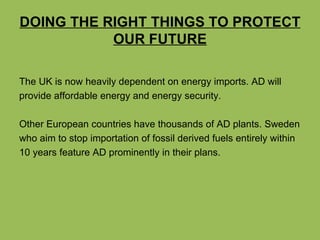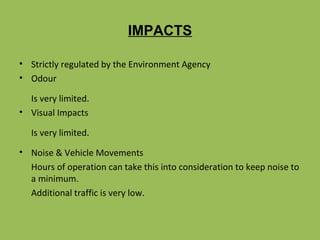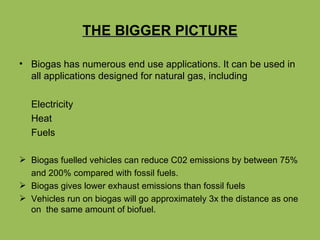Bgc Anaerobic Digestion
- 1. ANAEROBIC DIGESTION PRODUCING GREEN ENERGY FROM ORGANIC MATERIAL
- 2. WHAT IS ANAEROBIC DIGESTION ? A natural process which breaks down organic material in the absence of air. The decomposition is caused by natural bacteria action which produces biogases. These are contained, then converted into renewable energy, substantial heat is generated by the process that can be harnessed as well. A nutrient rich organic bulk and liquid fertilizer is a by product of the process.
- 3. WHAT CAN GO INTO AN ORGANIC ANAEROBIC DIGESTER? Grass Manure Sewage Sludge Animal Slurry Energy Crops
- 4. THE PROCESS Key Process Stages of Anaerobic Digestion
- 5. WHAT ARE THE BENEFITS OF ANAEROBIC DIGESTION ? Reduces emissions of carbon dioxide and methane (which is 23x as potent as carbon dioxide as a greenhouse gas). Reduces the amount going into landfill. Gives an opportunity for the government to meet targets. Produces high quality gas which can be converted into local affordable electricity, displacing fossil fuels. Produces a high quality fertilizer which can be spread directly onto the ground with reduced odour and very little land and water pollution risk. Reduces the amount of synthetic fertilizers needed (the production of 1 tonne of nitrogen results in he emission of 2 tonnes of carbon dioxide), further reducing emissions.
- 6. A CLOSED LOOP SUSTAINABLE SYSTEM Anaerobic digestion uses products which would probably otherwise be going to landfill, dumped or disposed of that produce energy, then returns the remaining digestate to the land. The digestate which can be applied straight to the land: Has very little if any odour. Contains nutrients in a form more available to crops than any manure initially entering the system. Has reduced run-off (therefore reduced pollution risk) Is hygienically safe and contains no risk of disease or weeds which have been destroyed in the process.
- 7. WE CAN PROVIDE A CLEAN LOCAL SOLUTION Climate Change Price of fuel, heat and energy Etc etc etc… Amount of fossil fuels Global Warming Waste going to landfill
- 8. DOING THE RIGHT THINGS TO PROTECT OUR FUTURE The UK is now heavily dependent on energy imports. AD will provide affordable energy and energy security. Other European countries have thousands of AD plants. Sweden who aim to stop importation of fossil derived fuels entirely within 10 years feature AD prominently in their plans.
- 9. WELSH ASSEMEBLY GOVERNMENT Jane Davidson is urging Councils to use AD as their preferred method for management of food waste. 70% of waste should be recycled, 30% turned into energy. Approximately 30-40 AD plants are needed across Wales We aim to help achieve a sustainable economy, and aid the proper management of resources.
- 10. AM I BOVERED ? These facilities are needed We aim to: Understand and address your concerns Provide you with accurate information THESE FACILTIES CAN BE A COMMUNITY ASSET
- 11. IMPACTS Strictly regulated by the Environment Agency Odour Is very limited. Visual Impacts Is very limited. Noise & Vehicle Movements Hours of operation can take this into consideration to keep noise to a minimum. Additional traffic is very low.
- 12. THE BIGGER PICTURE Biogas has numerous end use applications. It can be used in all applications designed for natural gas, including Electricity Heat Fuels Biogas fuelled vehicles can reduce C02 emissions by between 75% and 200% compared with fossil fuels. Biogas gives lower exhaust emissions than fossil fuels Vehicles run on biogas will go approximately 3x the distance as one on the same amount of biofuel.
- 13. FINAL THOUGHT As the great man himself once said: “ Never doubt that a small, group of thoughtful, committed citizens can change the world. Indeed, it is the only thing that ever has.” “ You must become the change you wish to see in this world.” Mahatma Gandi












